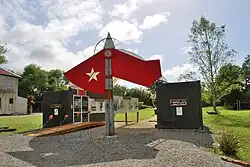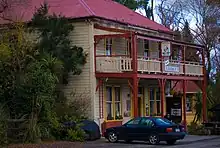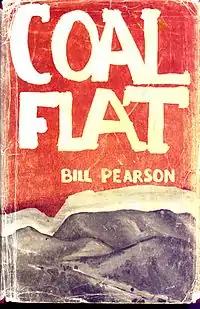Blackball, New Zealand
Blackball is a small town on the West Coast of the South Island of New Zealand, approximately 29 km from Greymouth. Elevation is approximately 100 metres. The town was named after the Black Ball Shipping Line, which leased land in the area to mine for coal.
Blackball | |
|---|---|
 Blackball Miners Strike Memorial | |
| Coordinates: 42°22′0″S 171°24′46″E | |
| Country | New Zealand |
| Region | West Coast |
| District | Grey District |
| Ward | Eastern |
| Electorates | |
| Government | |
| • Territorial authority | Grey District Council |
| • Regional council | West Coast Regional Council |
| • Mayor of Grey | Tania Gibson |
| • West Coast-Tasman MP | Maureen Pugh |
| • Te Tai Tonga MP | Tākuta Ferris |
| Area | |
| • Total | 1.94 km2 (0.75 sq mi) |
| Population (June 2023)[2] | |
| • Total | 300 |
| • Density | 150/km2 (400/sq mi) |
| Local iwi | Ngāi Tahu |

Blackball was a centre of New Zealand radicalism and workers' militancy. It is credited as the birthplace of (the predecessors of) the New Zealand Labour Party, which followed the 1908 miners 'cribtime' strike, at ten weeks the longest in New Zealand history.[3] In the 1913 Great Strike, Blackball miners were the last to return to work, in 1914. During the strike they had picketed miners in nearby Brunner and had burnt down the secretary of the 'arbitration' (strikebreaker) union's home. In 1925 the headquarters of the Communist Party of New Zealand moved to Blackball from Wellington. The pit closed in 1964.
History
The gold rush in the Moonlight district in 1864-65 heralded the birth of Blackball. In November 1865 a gold nugget was found in what was later called Blackball Creek but it was not until 1866 that gold in payable quantities was found in upper Blackball Creek. At the time, this area was known as Garden Gully but as gold continued to be found, it became known as Croesus.[4]
As the number of gold miners continued to increase, the difficulties of supplying them with food multiplied. The Plateau (later to be known as Blackball) was used as an over-night stop in the two-day journey from Greymouth. Huts and small store sheds gradually formed a small township which became known as Blackball.[4]
Blackball Workingmen's Club is one of the few old community organisations left in the town. Both the Oddfellows Lodge and the Buffaloes Lodge closed long ago. In its heyday Blackball had a Lodge of the Oddfellows Order. The Oddfellows Lodge played a major role in community life offering financial aid and self-improvement in the age before TV and State Social Security. The Oddfellows Hall was a major center of community activity and social life.
The Blackball lodge of the United Ancient Order of Druids was formed originally in 1906 and like most other organisations of its day has ceased to exist in Blackball.[5]
On 7 June 1941 the Blackball Lodge No 80 of the Royal Antediluvian Order of Buffaloes was opened In the Oddfellows Lodge Hall by the Provincial Grand Primo of the West Coast Bro. T.J.Preston KoM. The founders of the lodge were Bro. T.Durkin C.P. and Bro. T Nicolson C.P. both of whom would cycle 35 miles every fortnight just to attend lodge meetings of Blackball Lodge and thus fulfill their duties as Founders. The first officers of the Blackball Lodge No 80 were Bro. Durkin C.P.(Worthy Primo) Bro. Nicholson C.P. (Alderman of Benevolence) Bro. R. Cooke (City Chamberlain) Bro. J Moore (City Marshall) Bro. Reid (City Tyler) Bro. R Duggan (City Registrar) Bro. R Mountford (City Constable) Bro. A Ross (City Waiter) Bro. Johnston (City Minstrel) Bro. J Barry (City Treasurer) and Bro. M O'Flaherty (City Secretary)
Demographics
Blackball is defined by Statistics New Zealand as a rural settlement and covers 1.94 km2 (0.75 sq mi).[1] It had an estimated population of 300 as of June 2023,[2] with a population density of 155 people per km2. Blackball is part of the larger Barrytown statistical area.
| Year | Pop. | ±% p.a. |
|---|---|---|
| 2006 | 315 | — |
| 2013 | 276 | −1.87% |
| 2018 | 273 | −0.22% |
| Source: [6] | ||
Blackball had a population of 273 at the 2018 New Zealand census, a decrease of 3 people (−1.1%) since the 2013 census, and a decrease of 42 people (−13.3%) since the 2006 census. There were 138 households, comprising 153 males and 126 females, giving a sex ratio of 1.21 males per female, with 33 people (12.1%) aged under 15 years, 45 (16.5%) aged 15 to 29, 153 (56.0%) aged 30 to 64, and 51 (18.7%) aged 65 or older.
Ethnicities were 94.5% European/Pākehā, 12.1% Māori, 1.1% Pasifika, 2.2% Asian, and 2.2% other ethnicities. People may identify with more than one ethnicity.
Although some people chose not to answer the census's question about religious affiliation, 64.8% had no religion, 18.7% were Christian and 5.5% had other religions.
Of those at least 15 years old, 12 (5.0%) people had a bachelor's or higher degree, and 72 (30.0%) people had no formal qualifications. 18 people (7.5%) earned over $70,000 compared to 17.2% nationally. The employment status of those at least 15 was that 99 (41.2%) people were employed full-time, 39 (16.2%) were part-time, and 21 (8.8%) were unemployed.[6]
Railway
Blackball was the terminus of the New Zealand Railways Department's Blackball Branch, a branch line from the Stillwater–Westport Line. The line was approved in 1901, construction began in 1902 under the auspices of the Public Works Department, trains first ran in 1909, and it was officially opened on 1 August 1910. Private interests constructed a steep extension from Blackball into the Paparoa Ranges that employed the Fell mountain railway system to aid braking. This extension was later taken over by the State Mines Department and was known as the Roa Incline.
Passenger services operated to Blackball until 1940, primarily for the benefit of miners. Coal was the mainstay of the railway, and when tonnages dropped to an unsustainable level the Roa Incline closed on 25 July 1960. Trains to Blackball became increasingly infrequent, and when a flood destroyed two spans of the line's bridge over the Grey River on 21 February 1966, the Railways Department viewed repairs as unjustifiably expensive and closed the line. Blackball's station building had been destroyed by fire in 1955.
Restaurants, museums and recreation
The Blackball Museum of Working Class History opened in the town on 1 May 2010, in order to "celebrate the role working people have played in creating the infrastructure and wealth of a nation, [and] the part working people have played in creating society".[7]
The "Formerly the Blackball Hilton" hotel was founded in 1910 as the "Dominion Hotel", but in the 1970s renamed itself "Blackball Hilton" after the mine manager (after whom the town's main street, Hilton Street, is also named). The hotel changed its name after objections from the international hotel chain Hilton Hotels & Resorts.
An annual cycle race, the Blackball Working Men's Cycling Classic, was held in the town in January for three years: 2010–12.[8] Cyclists raced between Blackball and the nearby settlement of Atarau (Moonlight).
Literature
Blackball has a unique literary inheritance: for a small town, it has managed to attract more than its share of literary representations. Bill Pearson's Coal Flat (1963) is a major New Zealand novel in the dated social realist tradition. Pearson had taught in the town as a probationary teacher in 1942, and had formed a friendship with the publican's family. His book caused some consternation amongst the local people, as they tried to "spot the character" and identify who Pearson had based his characters on Pearson died in 2002.

Eric Beardsley's Blackball '08 is an historical novel published in 1984. Beardsley used the historic 1908 Crib Time strike[9] as the basis for a story that fleshed out the drama of what was a key moment in New Zealand trade union history. He published his biography Sliding down the Hypotenuse in 2011.[10]
Jeffrey Paparoa Holman wrote The Late Great Blackball Bridge Sonnets,[11][12] a collection of poetry published in 2004, which contains poems based around the railway bridge that linked the community with the outside world. The poems also mention people and features of the town, which Holman recalls from his childhood in Blackball during the 1950s and 1960s.
Paul Maunder, who lives in the town, is a playwright who has written and staged a number of plays about the town and working-class history.
Stevan Eldred-Grigg, who spent the first six years of his life in the town and now lives there once more, is a novelist and historian who has recently published a memoir about family life in 1950s Blackball.[13]
References
- "ArcGIS Web Application". statsnz.maps.arcgis.com. Retrieved 4 August 2023.
- "Subnational population estimates (RC, SA2), by age and sex, at 30 June 1996-2023 (2023 boundaries)". Statistics New Zealand. Retrieved 25 October 2023. (regional councils); "Subnational population estimates (TA, SA2), by age and sex, at 30 June 1996-2023 (2023 boundaries)". Statistics New Zealand. Retrieved 25 October 2023. (territorial authorities); "Subnational population estimates (urban rural), by age and sex, at 30 June 1996-2023 (2023 boundaries)". Statistics New Zealand. Retrieved 25 October 2023. (urban areas)
- "Returning to Labour's Roots". www.labour.org.nz. New Zealand Labour Party. 18 April 2016. Archived from the original on 3 April 2019. Retrieved 19 June 2017.
- Bowkett, A., ed. (1966). Blackball Centennial 1866-1966 official souvenir booklet. Grey District Library, West Coast Collection: Greymouth Evening Star.
- "Friendly Societies Registered Files United Ancient Order of Druids Blackball Lodge Miscellaneous (R20160903) 1906 - 1956". Archives New Zealand. Retrieved 17 February 2011.
- "Statistical area 1 dataset for 2018 Census". Statistics New Zealand. March 2020. 7023659 and 7023660.
- Home
- http://www.sportsground.co.nz/clubsite.asp?siteid=15682&pageid=56150&pagetypeid=1%5B%5D
- 7. – West Coast region – Te Ara Encyclopedia of New Zealand
- "Octogenarian's witty memoir will 'cause eyes to pop'". University of Canterbury. 13 September 2011. Archived from the original on 3 March 2016.
- Holman, Jeffrey Paparoa (28 September 2002). "The late great Blackball Bridge sonnets". New Zealand Listener. 185 (3255): 60–61. Archived from the original on 8 December 2022. Retrieved 8 December 2022 – via National Library of New Zealand.
- "The late great Blackball Bridge Sonnets by Jeffrey Paparoa Holman (Steele Roberts)". Archived from the original on 24 May 2010. Retrieved 5 April 2010.
- "Changing South: Blackball, the West Coast town that refused to die". MSN.
Bibliography
- Reed, A.W. (2002) The Reed dictionary of New Zealand place names. Auckland: Reed Books. ISBN 0-790-00761-4.
- Nolan, Melanie, ed. (2005). Revolution - The 1913 Great Strike in New Zealand. Canterbury: Canterbury University Press (in association with The Trades Union History Project). ISBN 1-877257-40-0.
- Beardsley, E. T. (1984). Blackball 08. Auckland: Collins. ISBN 0-00-222317-1. Historical Novel
- Eldred-Grigg, Stevan (2021). Green Grey Rain. Wellington and Christchurch: Piwaiwaka Press. ISBN 978-0-473-57151-1.
External links
 Media related to Blackball, New Zealand at Wikimedia Commons
Media related to Blackball, New Zealand at Wikimedia Commons- Formerly The Blackball Hilton Hotel
- Recollections of visiting Blackball in the early 1960s by Jim Hopkins